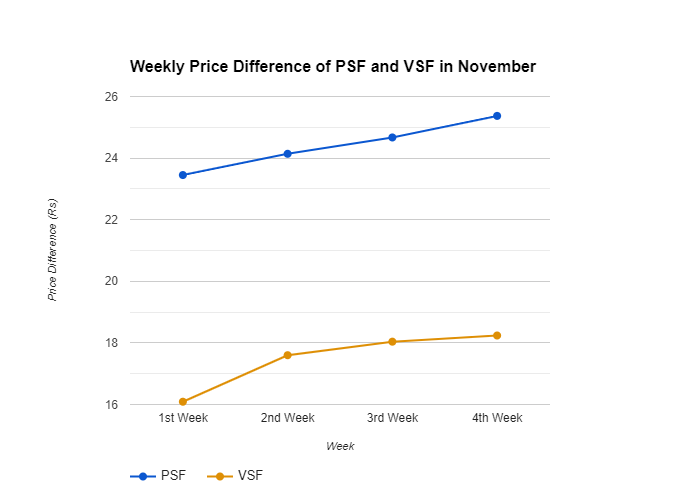Domestic prices of key fibres soar above international markets, impacts India’s textile industry

The Indian textile industry faces a growing challenge as domestic prices for Polyester Staple Fibre (PSF) and Viscose Staple Fibre (VSF) remain significantly higher than international rates. Data compiled by the Confederation of Indian Textile Industry (CITI) for November 2024 reveals a persistent and widening price disparity, which is likely to impact the cost competitiveness of Indian yarn manufacturers.
This trend is particularly concerning for the MSME sector, which relies heavily on competitive input costs to sustain production and compete with international manufacturers, especially in China, where raw material costs are lower.
Price gap a concerns
Throughout November, domestic prices for both PSF and VSF consistently outpaced international rates. The price gap was notably higher for PSF compared to VSF, with domestic PSF prices being approximately 30-35 per cent higher than international prices, while VSF prices were 11-13 per cent higher.
Table: Weekly price difference of PSF and VSF in November
|
November |
Fiber type |
Domestic price (Rs) |
International price (Rs) |
Price difference (Rs) |
Price difference (%) |
|
1st Week |
PSF |
98 |
74.55 |
23.45 |
31.45% |
|
VSF |
158 |
141.91 |
16.09 |
11.34% |
|
|
2nd Week |
PSF |
98 |
73.86 |
24.14 |
32.68% |
|
VSF |
158 |
140.4 |
17.6 |
12.54% |
|
|
3rd Week |
PSF |
98 |
73.33 |
24.67 |
33.65% |
|
VSF |
158 |
139.96 |
18.04 |
12.89% |
|
|
4th Week |
PSF |
98 |
72.63 |
25.37 |
34.93% |
|
VSF |
158 |
139.76 |
18.24 |
13.05% |
Key highlights
Larger price disparity for PSF: Domestic PSF prices saw a sharper price gap compared to VSF throughout the month, peaking at 34.93 per cent in the 4th week of November. Rising PSF costs could exert additional pressure on Indian manufacturers relying on synthetic fibres.
Stable exchange rates, persistent price gaps: The $/Rs exchange rate remained stable, fluctuating marginally between 84.21 and 84.41. However, this stability did little to narrow the price gap between domestic and international markets.
VSF shows moderate disparity
Price difference for VSF ranged from 11.34 per cent in the 1st week to 13.05 per cent by the 4th week. Although less steep than PSF, the gap remains significant for MSMEs relying on viscose-based inputs.
Impact on the industry
There are several reasons for this price disparity. One reason could be that domestic fibre manufacturers may be facing higher costs of production due to factors like higher energy prices or raw material import costs. Logistics issues or disruptions in the domestic supply chain could be contributing to higher prices. And insufficient domestic production of these fibres may be leading to a reliance on imports, exposing the industry to global price fluctuations.
These inflated domestic prices have several ramifications for the Indian textile industry. First it increases input costs and higher raw material costs squeeze profit margins for textile manufacturers, especially MSMEs, making them less competitive in both domestic and international markets. It also results in supply chain disruptions and cost increase can lead to production cuts and potential delays in fulfilling orders. Exports will be impacted as higher prices make Indian textiles less attractive in the global market, potentially leading to a decline in exports and loss of valuable foreign exchange. At the same time, imports will rise as the price difference could incentivize some manufacturers to import cheaper fibres, potentially hurting domestic fibre producers.
The way forward
Addressing this price disparity requires a multi-pronged approach. First, increasing domestic production of PSF and VSF can help reduce reliance on imports and stabilize prices. It’s important to improve supply chain efficiency. Streamlining logistics and addressing bottlenecks in the supply chain can help reduce costs. And government support is vital. Policies aimed at supporting domestic fibre manufacturers and the textile industry, such as tax breaks or subsidies, could help alleviate some of the pressure.
This issue requires urgent attention from both the government and industry stakeholders to ensure the long-term health and competitiveness of India's vital textile sector.
